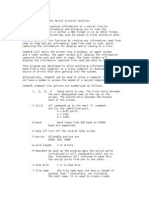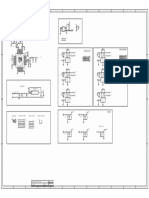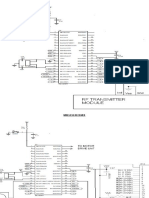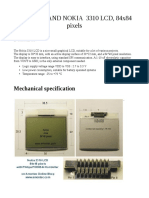PIC+l293d Document
PIC+l293d Document
Uploaded by
madduanilCopyright:
Available Formats
PIC+l293d Document
PIC+l293d Document
Uploaded by
madduanilOriginal Description:
Original Title
Copyright
Available Formats
Share this document
Did you find this document useful?
Is this content inappropriate?
Copyright:
Available Formats
PIC+l293d Document
PIC+l293d Document
Uploaded by
madduanilCopyright:
Available Formats
DC Motor and L293D
We cant drive a DC Motor (depends) directly with a Microcontroller, as DC Motors requires high current and high voltage than a Microcontroller can handle. Microcontrollers usually operates at +5 or +3.3V supply and it I/O pin can provide only up to 25mA current. Commonly used DC Motors requires 12V supply and 300mA current, moreover interfacing DC Motors directly with Microcontrollers may affect the working of Microcontroller due to the Back EMF of the DC Motor. Thus it is clear that, it not a good idea to interface DC Motor directly with Microcontrollers. The solution to above problems is to use H-bridge circuit.
Basic H-Bridge DC Motor Driving
It is a special circuit, by using the 4 switches we can control the direction of DC Motor. Depending upon our power requirements we can make our own H-bridge using Transistors/MOSFETs as switches. It is better to use ready made ICs, instead of making our own H-bridge. L293D and L293 are two such ICs. These are dual H-bridge motor drivers, ie by using one IC we can control two DC Motors in both clock wise and counter clockwise directions. The L293D can provide bidirectional drive currents of up to 600-mA at voltages from 4.5 V to 36 V while L293 can provide up to 1A at same voltages. Both ICs are designed to drive inductive loads such as dc motors, bipolar stepping motors, relays and solenoids as well as other high-current or highvoltage loads in positive-supply applications. All inputs of these ICs are TTL compatible and output
clamp diodes for inductive transient suppression are also provided internally. These diodes protect our circuit from the Back EMF of DC Motor.
PIN Diagram of L293D
In both ICs, drivers are enabled in pairs, with drivers 1 and 2 are enabled by a high input to 1,2EN and drivers 3 and 4 are enabled by a high input to 3,4EN. When drivers are enabled, their outputs will be active and in phase with their inputs. When drivers are disabled, their outputs will be off and will be in the high-impedance state.
Function Table of L293D
Interfacing with PIC Microcontroller
Circuit Diagram
Interfacing DC Motor with PIC Microcontroller and L293D Circuit Diagram
Note: VDD and VSS of the pic microcontroller is not shown in the circuit diagram. VDD should be connected to +5V and VSS to GND. We can drive two DC Motors with one L293D, in this example we are using only the first pair of drivers to drive one DC Motor. First pair of drivers are enabled by connecting EN1 to Logic HIGH.
IN1 and IN2 are connected to RB0 and RB1 of PIC Microcontroller respectively which are used to provide control signal to the DC Motor. DC Motor is connected to OUT1 and OUT2 of the L293D.
MikroC Source Code
void main() { CMCON = 0x07; // To turn off comparators ADCON1 = 0x06;// To turn off ADC TRISB = 0; // PORT B as output port PORTB = 1; // Set RB0 to high do { //To turn motor clockwise PORTB.F0 = 1; Delay_ms(2000);//2 seconds delay
//To Stop motor PORTB = 0; // or PORTB = 3 Delay_ms(2000);//2 seconds delay
//To turn motor anticlockwise direction PORTB.F1 = 1; Delay_ms(2000);//2 seconds delay
//To Stop motor PORTB = 0; // or PORTB = 3 (3 = 0b00000011) Delay_ms(2000); // 2 seconds delay
}while(1); }
Control Signals and Motor Status
RB0/IN1 RB2/IN2 MOTOR STATUS
LOW LOW HIGH HIGH
LOW HIGH LOW HIGH
Stops Anti-Clockwise Clockwise Stops
You might also like
- PTCL Report of 8Document46 pagesPTCL Report of 8HAFIZ ABDUL HAYE BAKHTIARNo ratings yet
- Silicon Controlled RectifierDocument9 pagesSilicon Controlled RectifierFarishat Nusabbee An Nafs100% (1)
- Induction Motor Drive Using Thyristor Based Cycloconverter For Variable Torque Load ApplicationDocument5 pagesInduction Motor Drive Using Thyristor Based Cycloconverter For Variable Torque Load ApplicationIJIRST100% (2)
- Bidirectional Current Source-TIDocument9 pagesBidirectional Current Source-TIestraj1954100% (1)
- ICD2 Poster 51265hDocument1 pageICD2 Poster 51265hngt881100% (1)
- USB To RS232 Using Atmel ATtiny2313 or ATmega8Document4 pagesUSB To RS232 Using Atmel ATtiny2313 or ATmega8Nugraha Indrawan100% (2)
- A 2.4 GHZ Gaas-Hbt Class-E Mmic Amplifier With 65% PaeDocument4 pagesA 2.4 GHZ Gaas-Hbt Class-E Mmic Amplifier With 65% PaeKevin Dany100% (1)
- Indus Lecture 2 PartialDocument69 pagesIndus Lecture 2 PartialIris Jean Mosquera100% (1)
- Morse Code Astable OscillatorDocument2 pagesMorse Code Astable OscillatorFeher Catalin100% (1)
- 4 Bit Mode AssiDocument6 pages4 Bit Mode AssiSisay AD100% (2)
- Diode Clipping CircuitsDocument6 pagesDiode Clipping CircuitsPotchinoParuntong100% (1)
- Default Switch/Jumper SettingsDocument16 pagesDefault Switch/Jumper SettingsRafael Avella100% (1)
- Datasheet Sen23292pDocument15 pagesDatasheet Sen23292pjessie100% (1)
- For Mcu: VCC OUTDocument9 pagesFor Mcu: VCC OUTautrera100% (2)
- Microstepping TutorialDocument5 pagesMicrostepping TutorialDave Chan100% (1)
- Port PDFDocument16 pagesPort PDFdharanika100% (1)
- Datasheet LCDDocument8 pagesDatasheet LCDSebasXR100% (1)
- Serial LCD: Searchresults/Tabid/768/List/0 /Sortfield/4/Productid/51/Def Ault - Aspx?Txtsearch Serial+LcdDocument5 pagesSerial LCD: Searchresults/Tabid/768/List/0 /Sortfield/4/Productid/51/Def Ault - Aspx?Txtsearch Serial+Lcddimas100% (3)
- Paso A PasaDocument1 pagePaso A PasaAlejandro Teruggi100% (1)
- CapacitorDocument2 pagesCapacitorsrinu247100% (1)
- Power KSC-570Document1 pagePower KSC-570Lucie Pavlíčková100% (1)
- XL MaxSonar WR - Datasheet PDFDocument26 pagesXL MaxSonar WR - Datasheet PDFfernandoviolante8551100% (1)
- L296 SchematicDocument1 pageL296 SchematicmyEbooks100% (1)
- History of The I2C BusDocument24 pagesHistory of The I2C BusManoj Kavedia100% (1)
- 17pw17 2Document1 page17pw17 2korodiferenc9258100% (1)
- PL301 Submersible Level Transmitter PDFDocument2 pagesPL301 Submersible Level Transmitter PDFAdil100% (1)
- CommchkDocument4 pagesCommchkjamesyu100% (1)
- HC SR04 PDFDocument3 pagesHC SR04 PDFVipan Sharma100% (1)
- Digital ClockDocument1 pageDigital ClockBond James100% (1)
- Gems Pressure Transducer PDFDocument5 pagesGems Pressure Transducer PDFFelix Alex de Vera100% (1)
- Nec Ir For PicDocument14 pagesNec Ir For Picsudhakar5472100% (2)
- Guia Basica de Ejercicios-ProtonDocument59 pagesGuia Basica de Ejercicios-ProtonFatality Joseph100% (1)
- Demi Winner X Ble: Demi Left Demi RightDocument1 pageDemi Winner X Ble: Demi Left Demi RightTu Do100% (2)
- Overview of The Inter-Integrated Circuit (I C) Bus: 2 ECPE 4536 Microprocessor System Design II Virginia TechDocument7 pagesOverview of The Inter-Integrated Circuit (I C) Bus: 2 ECPE 4536 Microprocessor System Design II Virginia Techdineshvhaval100% (1)
- DC Motor Control Using C++Document8 pagesDC Motor Control Using C++Atto100% (2)
- HC Sr04Document4 pagesHC Sr04Shofol Biswas100% (1)
- Agribot Project PresentationDocument21 pagesAgribot Project Presentationumaiya1990100% (1)
- Thyristor As A SwitchDocument4 pagesThyristor As A Switchuqink100% (2)
- 5V3AUPSR2 SchematicDocument1 page5V3AUPSR2 SchematicAkhil A B100% (1)
- My Ref Rev3 RefCDocument1 pageMy Ref Rev3 RefCDanang Prasetiyo100% (1)
- Lab LCDDocument6 pagesLab LCDJesus Cotrina100% (1)
- Diacs: DIAC, or Diode For Alternating Current, Is A Trigger Diode That Conducts CurrentDocument4 pagesDiacs: DIAC, or Diode For Alternating Current, Is A Trigger Diode That Conducts Currentyuj o100% (1)
- Lv-Maxsonar - Ez™ Series: High Performance Sonar Range FinderDocument11 pagesLv-Maxsonar - Ez™ Series: High Performance Sonar Range FinderBubaka Abu Naufal100% (2)
- Schematic1 - Page1Document1 pageSchematic1 - Page1Jeong-geun Kim100% (1)
- 17pw16 1Document1 page17pw16 1korodiferenc9258100% (1)
- PcbdesigningDocument16 pagesPcbdesigningPraveen Kumar Chitluri100% (1)
- Programacion IcspDocument8 pagesProgramacion IcspGerardo Madrigal100% (2)
- An-960 RS 485 Incl Termination DetailsDocument12 pagesAn-960 RS 485 Incl Termination Detailsqafqgibsonq4543100% (1)
- LCD 4 Bit InterfacingDocument6 pagesLCD 4 Bit InterfacingYogesh Hardiya100% (1)
- Microwave ConsoleDocument1 pageMicrowave ConsoleMochammad Praditia100% (1)
- Arduino Wifi Shield Schematic - 2 PDFDocument1 pageArduino Wifi Shield Schematic - 2 PDFHich Em100% (1)
- Development Kit For E-Paper Display: Dalian Good Display Co., LTDDocument14 pagesDevelopment Kit For E-Paper Display: Dalian Good Display Co., LTDjhonatan cock100% (1)
- Pick It 2Document1 pagePick It 2bleem41100% (1)
- xc7s15 1ftgb196 v02 PDFDocument3 pagesxc7s15 1ftgb196 v02 PDFjoejond100% (2)
- LCD Interfacing With ATmega32Document6 pagesLCD Interfacing With ATmega32nandoclasic100% (2)
- By Ligo George MikroC, PIC Microcontroller InterfcingDocument5 pagesBy Ligo George MikroC, PIC Microcontroller InterfcingLawrence NgariNo ratings yet
- DC Motor ControlDocument5 pagesDC Motor ControlSiddhasen PatilNo ratings yet
- DC-Motor Driver Circuits: Using TransistorDocument14 pagesDC-Motor Driver Circuits: Using TransistorSyar ArifNo ratings yet
- WorkingDocument3 pagesWorkingAnuj TripathiNo ratings yet
- L293D Is A DualDocument3 pagesL293D Is A DualRamya IyerNo ratings yet
- Chapter 1 - Group 1Document6 pagesChapter 1 - Group 1NATHANIEL YACASNo ratings yet
- Mesa County Forensic Report No 3Document88 pagesMesa County Forensic Report No 3Aa ANo ratings yet
- Info Kit Circo AlemaniaDocument6 pagesInfo Kit Circo AlemaniaMundusNo ratings yet
- NetCol5000-A025&035H (300mm) In-Row Air Cooled Cooling Product Datasheet...Document2 pagesNetCol5000-A025&035H (300mm) In-Row Air Cooled Cooling Product Datasheet...Leonardo GonzálezNo ratings yet
- Linux - How To Correct Postfix' 'Relay Access Denied' - Server FaultDocument3 pagesLinux - How To Correct Postfix' 'Relay Access Denied' - Server FaultjorgetbastosNo ratings yet
- Cease and Desist - Jericho Labonte (1) - 2Document3 pagesCease and Desist - Jericho Labonte (1) - 2Jericho LabonteNo ratings yet
- R Rec P.618 10 200910 I!!pdf eDocument26 pagesR Rec P.618 10 200910 I!!pdf erard111No ratings yet
- Research On Bilingual Education in Taiwan's High SchoolsDocument12 pagesResearch On Bilingual Education in Taiwan's High SchoolsGlobal Research and Development ServicesNo ratings yet
- 22 0252 VIP MenuUpdate QC EN NCDocument9 pages22 0252 VIP MenuUpdate QC EN NCAmA ChannelNo ratings yet
- GST CertificateDocument3 pagesGST CertificatePeppyPlants plantsNo ratings yet
- Ios Collection 2008Document22 pagesIos Collection 2008cursociscoNo ratings yet
- 580 SchlosserDocument51 pages580 Schlosserbosra matilendoNo ratings yet
- 49 - Spinning - AmslerDocument1 page49 - Spinning - AmslerWajih HashmiNo ratings yet
- Title I Obligations (Arts. 1156-1304.)Document46 pagesTitle I Obligations (Arts. 1156-1304.)Rica Banggud100% (2)
- Axis Communications Technical Support AXIS 205 Network CameraDocument9 pagesAxis Communications Technical Support AXIS 205 Network CamerahgilNo ratings yet
- Unit 3 - MTICDocument77 pagesUnit 3 - MTICMahesh NegiNo ratings yet
- RMC AustDocument11 pagesRMC AustkomalNo ratings yet
- 0 1Document4 pages0 1Sayantan HalderNo ratings yet
- 21 Differential Cost AnalysisDocument7 pages21 Differential Cost AnalysisDerrick de los ReyesNo ratings yet
- Advanced Financial Accounting and ReportingDocument18 pagesAdvanced Financial Accounting and Reportingedrick LouiseNo ratings yet
- Comp9020 Cheatsheet CrefDocument2 pagesComp9020 Cheatsheet Crefzx136152382No ratings yet
- PPG - PSX700 (FD)Document15 pagesPPG - PSX700 (FD)scibduser001No ratings yet
- EMS TextbookDocument45 pagesEMS TextbookApri Hady100% (1)
- Palliative Care MSP Billing Cheat SheetDocument7 pagesPalliative Care MSP Billing Cheat Sheetmorganator1217No ratings yet
- SWOT Analyses of General Motors India PVTDocument12 pagesSWOT Analyses of General Motors India PVTshan birlaNo ratings yet
- Bonus OrderDocument4 pagesBonus OrderDamai VenkatadriNo ratings yet
- Euramet PDFDocument23 pagesEuramet PDFIgor GrujićNo ratings yet
- Accreditation of Hospitals: The Situation in GermanyDocument3 pagesAccreditation of Hospitals: The Situation in GermanyajithaNo ratings yet
- HECO U1 - Pharm Business Firm1Document133 pagesHECO U1 - Pharm Business Firm1Tin SagmonNo ratings yet

























































































